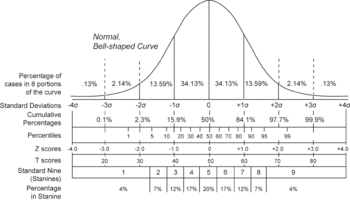Standard score
In statistics, the standard score is the signed number of standard deviations by which an observation or data is above the mean. A standard score is a derived score, used for making norm-referenced interpretations, for which the mean and standard deviation are selected to simplify interpretations. Some common standard scores and their corresponding mean and standard deviation are: ACT scores (18 and 5), SAT scores (500 and 100), T-scores (50 and 10), and z-scores (0.0 and 1.0).[1] A positive standard score indicates a datum above the mean, while a negative standard score indicates a datum below the mean. It is a dimensionless quantity obtained by subtracting the population mean from an individual raw score and then dividing the difference by the population standard deviation. This conversion process is called standardizing or normalizing (however, "normalizing" can refer to many types of ratios; see normalization for more).
Standard scores are also called z-values, z-scores, normal scores, and standardized variables; the use of "Z" is because the normal distribution is also known as the "Z distribution". They are most frequently used to compare a sample to a standard normal deviate, though they can be defined without assumptions of normality.
The z-score is only defined if one knows the population parameters; if one only has a sample set, then the analogous computation with sample mean and sample standard deviation yields the Student's t-statistic.
Calculation from raw score
The standard score of a raw score x[2] is
where:
- μ is the mean of the population.
- σ is the standard deviation of the population.
The absolute value of z represents the distance between the raw score and the population mean in units of the standard deviation. z is negative when the raw score is below the mean, positive when above.
A key point is that calculating z requires the population mean and the population standard deviation, not the sample mean or sample deviation. It requires knowing the population parameters, not the statistics of a sample drawn from the population of interest. But knowing the true standard deviation of a population is often unrealistic except in cases such as standardized testing, where the entire population is measured. In cases where it is impossible to measure every member of a population, the standard deviation may be estimated using a random sample.
It measures the sigma distance of actual data from the average.
The Z value provides an assessment of how off-target a process is operating.
Applications
The z-score is often used in the z-test in standardized testing – the analog of the Student's t-test for a population whose parameters are known, rather than estimated. As it is very unusual to know the entire population, the t-test is much more widely used.
Also, standard score can be used in the calculation of prediction intervals. A prediction interval [L,U], consisting of a lower endpoint designated L and an upper endpoint designated U, is an interval such that a future observation X will lie in the interval with high probability , i.e.
For the standard score Z of X it gives:[3]
By determining the quantile z such that
it follows:
Standardizing in mathematical statistics
In mathematical statistics, a random variable X is standardized by subtracting its expected value and dividing the difference by its standard deviation
If the random variable under consideration is the sample mean of a random sample of X:
then the standardized version is
- .
T-score
A T-score is a standard score Z shifted and scaled to have a mean of 50 and a standard deviation of 10.[4][5][6]
See also
References
- ↑ National Council on Measurement in Education. Glossary.
- ↑ E. Kreyszig (1979). Advanced Engineering Mathematics (Fourth ed.). Wiley. p. 880, eq. 5. ISBN 0-471-02140-7.
- ↑ E. Kreyszig (1979). Advanced Engineering Mathematics (Fourth ed.). Wiley. p. 880, eq. 6. ISBN 0-471-02140-7.
- ↑ John Salvia; James Ysseldyke; Sara Witmer (29 January 2009). Assessment: In Special and Inclusive Education. Cengage Learning. pp. 43–. ISBN 0-547-13437-1.
- ↑ Edward S. Neukrug; R. Charles Fawcett (1 January 2014). Essentials of Testing and Assessment: A Practical Guide for Counselors, Social Workers, and Psychologists. Cengage Learning. pp. 133–. ISBN 978-1-305-16183-2.
- ↑ Randy W. Kamphaus (16 August 2005). Clinical Assessment of Child and Adolescent Intelligence. Springer. pp. 123–. ISBN 978-0-387-26299-4.
Further reading
- Carroll, Susan Rovezzi; Carroll, David J. (2002). Statistics Made Simple for School Leaders (illustrated ed.). Rowman & Littlefield. ISBN 978-0-8108-4322-6. Retrieved 7 June 2009.
- Larsen, Richard J.; Marx, Morris L. (2000). An Introduction to Mathematical Statistics and Its Applications (Third ed.). p. 282. ISBN 0-13-922303-7.
